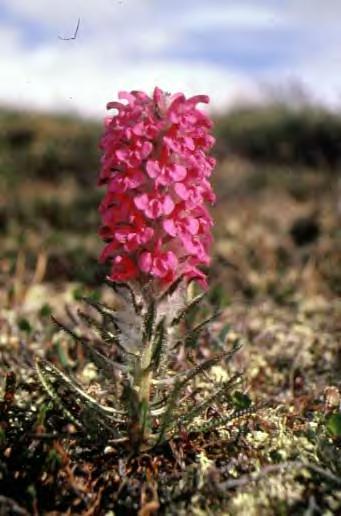
ARCTIC TUNDRA PLANTS
Trees do not grow on the tundra. Since most of the soil remains frozen, the roots cannot grow and take in enough water. Plants with shorter roots do live there. They grow close to the ground where they are protected from the strong arctic winds.
Tundra plants need as much warmth as they can get. Like other plants, they make their own food using the energy in sunlight. But like other plants, they cannot make their own heat. The tundra chill slows down food making. Many tundra plants grow together in thick mats or have fine hairs to trap any warmth there is.
In summer, the soil does not dry out in the sun and the ground stays muddy. The permafrost stops the melting snow from soaking any deeper into the ground. Held at the surface the water forms ponds and bogs that provide moisture for plants, thereby counteracting the low precipitation.
ARCTIC POPPY- This plant is a bowl-shaped yellow poppy. The hairs on the stems help hold in water and keep the plant warm by trapping warm air around them. The colorful blossoms absorb more of the sunís rays than white flowers do. To capture the sunís warmth, the arctic poppy flower turns so it is always facing the sun. The flower needs warmth in order to make seeds.

REINDEER MOSS LICHEN- Lichen is a very important plant on the tundra. It is the main food of Caribou, Lemming, and other animals. Lichens are unusual organisms that often grow on exposed rock surfaces. They are composed of a fungus and an algae living and growing together. Rocks help keep plants warm by sheltering them from the wind. Lichens help make soil. As they grow, they slowly give off chemicals that wear away rock.

SAXIFRAGE- This plant grows in a low tight cushion in order to trap the sunís heat. It sends out shoots to start new plants. Its buds can live through the winter and bloom in the spring. The dark red leaves allow the plant to absorb more heat from the sun in the cold tundra climate.

ARCTIC RHODODENDRON- This plant has waxy leaves that prevent water loss. The dark cup-shaped flower directs sunlight toward the flowerís center, where its seeds grow.

FERNWEED/WOOLY LOUSEWORT- This small round plant looks like it is covered with fuzzy white wool. This wool is actually tiny hair that protects it from cold in early spring and the hot sun in the summer. The hairs also help the plant to stay moist. This plant may grow to be 10 inches tall and have one to several stalks with thick, long stemmed, alternating basal leaves. The basal leaves have serrated leaflets that are kind of purple when young. They bloom in early May to late June with many pleasant smelling pink flowers. This plant has a long tap root because of the habitat it grows in. It can be found in dry, stony tundra areas.

COTTON GRASS- This plant is stiff and has linear leaves that look like blades of grass. The seedpods are soft, white, and have hairy heads at the top of the stalk. The seedpods open up in June and July. Cotton Grass seeds are dispersed across the tundra when their wings are caught by the wind. This plant is adapted to sweeping winds and to soil disturbances from frost heaves. They carry on photosynthesis at low temperatures, low light intensities, and long periods on daylight. The cotton grows twelve to fifteen inches tall. The lower stems and roots are edible and mice collect them.

SEDGE- Sedge is a grasslike flowering plant with characteristically triangular stems. They are abundant in wet marshy areas of the subarctic zones. Sedge has a root-like underground stem out of which grows a tuft of basal leaves. The leaf bases expand into sheaths that entirely close around the stem. The stem itself is usually unbranched and leafless with a cluster of inconspicuous flowers at its tip. The flower is reduced to a series of scales or bristles rather than a showy petal. They are adapted to sweeping winds and carry on photosynthesis at low temperatures and low light intensities.

SHOOTING STAR- This flower is called a Shooting Star because it resembles a falling star. It looks like itís bowing its head. The Shooting Starís petals are pink with a white ring next to the stamen. This unique flower blooms from mid-June through late July and has a faint but nice smell. In the flower
there are five sepals, the outer green part of the flower keeping it cozy when in bud. The leaves are spaded shaped and basal. They like to grow on the damp wet tundra. Sometimes this plant can grow 10 inches tall.

FORGET-ME-NOT- This gorgeous, delicate plant has a long stem with blue flowers clustered at the top. It usually grows from 6 to 15 inches tall. The leaves look like broad blades of grass and have an abundance of stiff hairs on them. The hairs help hold in water and keep the plant warm. They are also very large stemmed. The five petals on each flower are symmetrical and are usually light blue with a yellow circle and a white dot in the center. The colorful blossoms absorb the sunís rays. By hugging the ground, they escape the full force of chilly, drying winds. As the sun warms the ground, the ground warms the air just above the plant a few extra degrees. This plant looks very exquisite when in bloom.

CUSHION PLANTS- Cushion Plants grow in a low, tight clump and look like a little cushion. These plants are more common in the tundra where their growth habit helps protect them from the cold. They are adapted to gusting winds, heavy snow, and widely fluctuating temperatures. They carry on photosynthesis under brilliant light in short periods of daylight.
